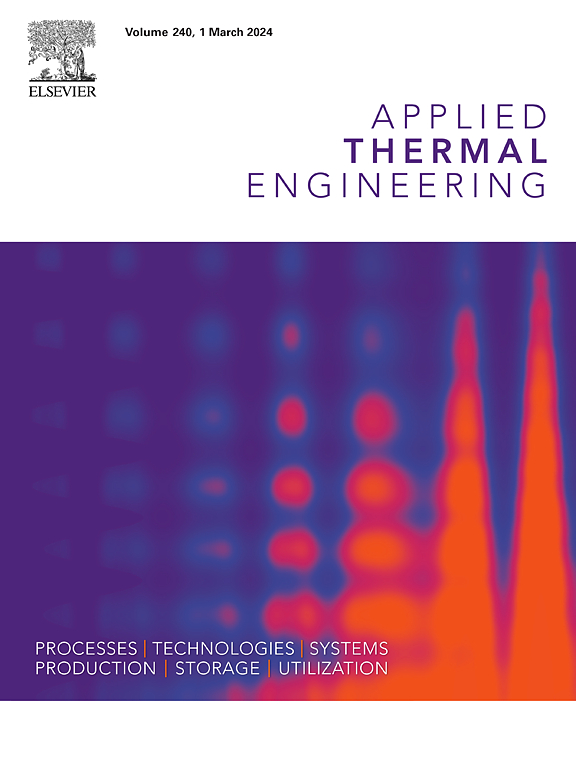Heat transfer enhancement for high power chips in immersion cooling by ducted propellers
IF 6.1
2区 工程技术
Q2 ENERGY & FUELS
引用次数: 0
Abstract
Immersion cooling offers significant potential for various scenarios facing increasingly severe heat dissipation challenges. Increasing the overall flowrate of immersion cooling is a non-efficient method to enhance the heat dissipation for high power chips, since most of components can be cooled with very small flow velocity. To alleviate the hotspots issues while minimizing cooling power consumption, this study proposes a design of installing ducted propellers to accelerate the local fluid flow around the high power chips to improve their heat dissipation performance. The numerical simulations were conducted with varied installation position and duct shape, and dual-propeller configurations. The coolant is FC40, the heat load for a 40*40 mm heat source is 400 W, the free stream velocity is 0.5 m/s, and the propellers is working under 2500 revolutions per minute (rpm). The ducted propeller positioned at the rear of the heat sink reduces the average temperature of the heat source by 6.2 °C, and the inlet velocity is increased by 15.9 % and the outlet velocity is increased by 213.0 %. The rear-mounted propeller covered a wider area than the front-mounted one, while the front-mounted ducted propeller exhibited better local heat transfer enhancement in central channels of the heat sink. The rectangular duct positively contributes to improving the uniformity of the heat source surface temperature and performs better than the circular duct in the front-mounted configuration with a 1.5°C lower maximum temperature. Single propeller exhibits the intrinsic weakness that the side channels can hardly by influenced by suction effect, resulting the hot spots at the side region near the outlet. The dual-propeller design provided a pronounced enhancement in heat dissipation, lowering the maximum temperature of the heat source surface by 15.6 °C and reducing the temperature difference by 10.4 °C compared to the case without propellers. The maximum power consumption for single and dual propellers is 0.31 W and 0.56 W, respectively. The results demonstrate that the ducted propeller is a good candidate for heat transfer enhancement, hotspot temperature control and cooling power saving for immersion cooling server with high power chips.
求助全文
约1分钟内获得全文
求助全文
来源期刊

Applied Thermal Engineering
工程技术-工程:机械
CiteScore
11.30
自引率
15.60%
发文量
1474
审稿时长
57 days
期刊介绍:
Applied Thermal Engineering disseminates novel research related to the design, development and demonstration of components, devices, equipment, technologies and systems involving thermal processes for the production, storage, utilization and conservation of energy, with a focus on engineering application.
The journal publishes high-quality and high-impact Original Research Articles, Review Articles, Short Communications and Letters to the Editor on cutting-edge innovations in research, and recent advances or issues of interest to the thermal engineering community.
 求助内容:
求助内容: 应助结果提醒方式:
应助结果提醒方式:


